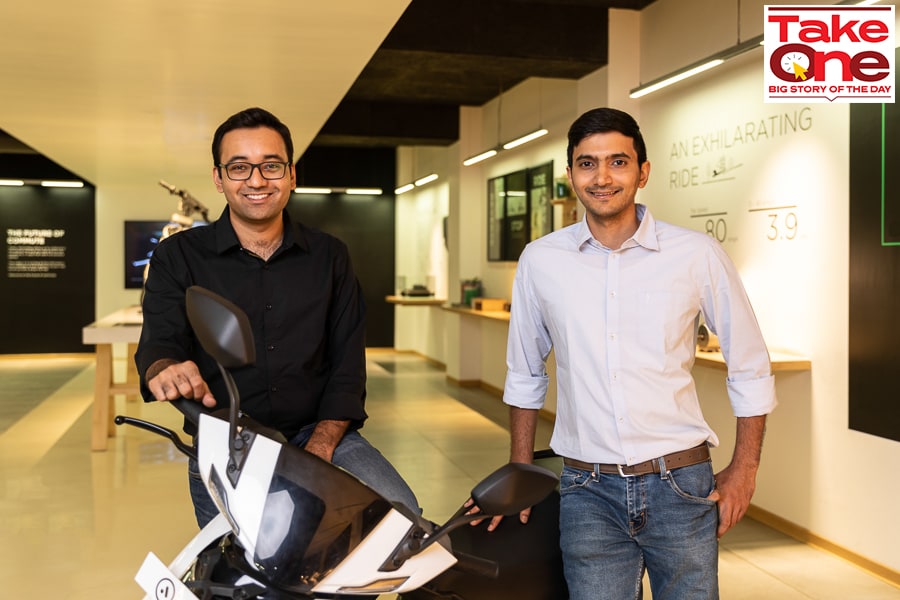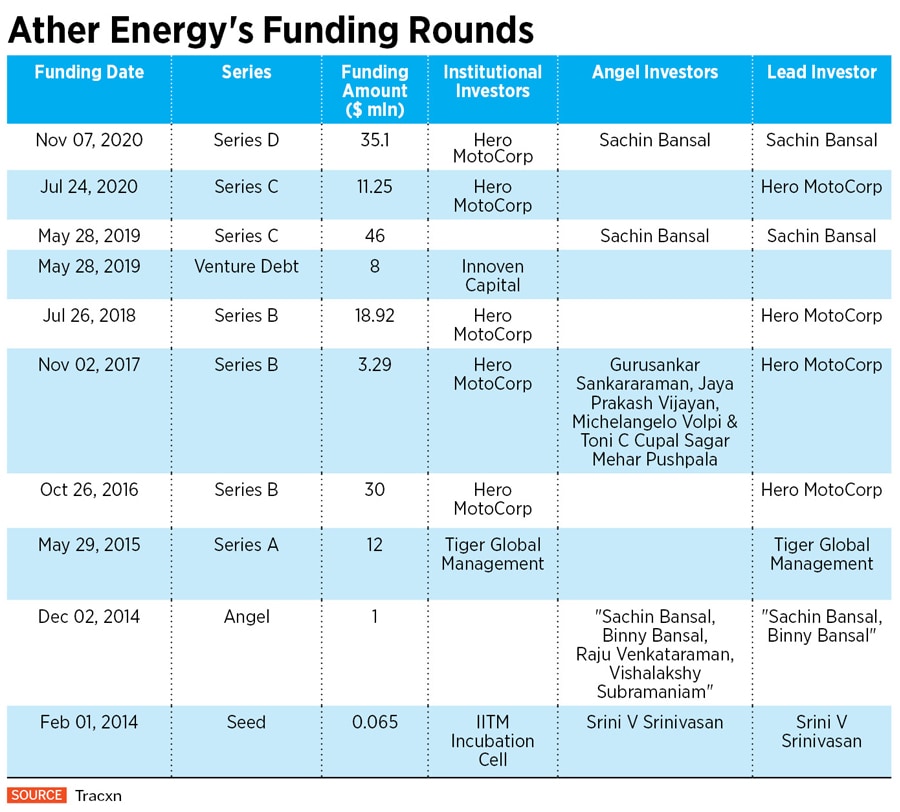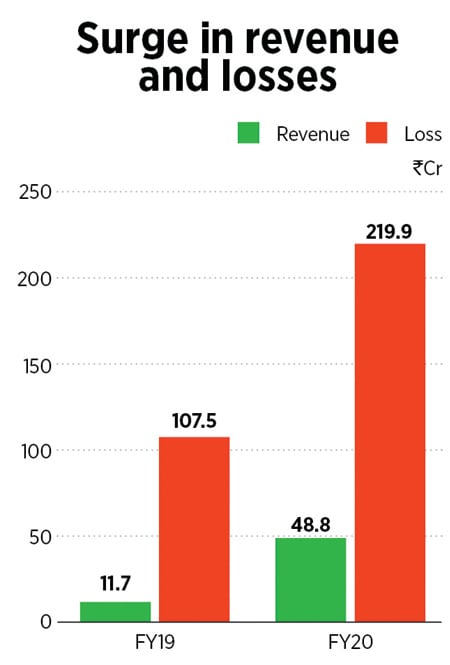If all goes well, especially with India’s struggle with the Covid pandemic, Ather could get to the point where it will have cleared the base of the hockey stick—ready for serious growth. In fact, the company’s performance in the first three months of the current calendar year shows that.
“Just the last month of the last quarter was like one-third of our annual revenue. We saw solid growth," CEO Tarun Mehta tells Forbes India.
At the end of last year, Ather was present in only two cities—Bengaluru and Chennai—and the company was still selling an older generation of scooter, Ather 450. It moved to the 450X sometime in November and that’s when the product-market-fit clicked and growth got supercharged. From November 2020 to March 2021, retail sales grew roughly 5x, Mehta says, and Benguluru, the company’s most established market, is seeing almost two-and-a-half times as many scooters sold in a month versus November last year.
“Numbers have truly skyrocketed, inquiries are 10x higher, and we are only able to service 20 percent of people who book a test drive, so we are now at a place where essentially the biggest focus of the company is getting more distribution going," he says.
Positive unit economics
The January-March quarter of FY21 was significant for Ather for another important reason. “For the first time, we had positive gross margins, positive unit economics," Mehta says, meaning if one keeps aside all the overheads involved in making an Ather 450X, the scooter by itself is no longer costing Ather money. And positive Ebitda for this particular variant is quite doable sometime next year, he adds.
The number of cities in which Ather is present went up to 10 by the end of March. The public charging points the company itself sets up shot up from 40 to 130, and the company is adding 20 to 30 points every month now. “I would say Ather really started selling in the last one year. Before that it was all a grand controlled experiment in what customers really wanted," says Mehta.
Customers have changed too. When Ather started in 2013, people had to be convinced that electric vehicles (EV) were a better option. Today, people expect their EVs to be an upgrade from their petrol vehicles, explains Mehta. The first generation Ather 450, last year, was still a bit of an every-person scooter. It was not defined sharply enough to appeal to a particular customer segment.
Ather 450X
The 450X which was launched in October-November last year, on the other hand, appeals to that rider who wants to have fun with a high-end, responsive ride. This is the segment that scooters such as NTorq, Aprillia and Burgman are positioned for.
The 450X was a consolidated effort over an 18-month period, says Swapnil Jain, co-founder and CTO. Many changes have been made under the hood, including a total revamp of the electrical architecture and a redesign of the battery pack with a different cell form factor and a change in the cell chemistry itself that allowed Ather to pack in more energy for performance and improve battery life as well. The powertrain was also tweaked to ensure that it would withstand the performance jump that was brought in from the 450 to the 450X.
And, while not customer-facing, there were many changes made to improve the manufacturability of the 450X. This involves finding the right combination of person-effort needed and the number or units that need to be rolled out and ridding the entire process of errors, thereby minimising scrap.
The dashboard got new software too—one built on Android versus the previous Linux-based system. That means the entire module which connects to the cloud, the user interface, the human-machine interface, and the navigation system are all now Android-based, in the 450X.
While Linux offered a robust platform to build on—and in fact was better from a performance perspective—Ather needed the Android software ecosystem for the future mass production it anticipates, when developers will be able to build third-party apps for Ather, for example. And the company also switched a particular semiconductor chip to one from Qualcomm, which only supported Android.
With the 450X, “we set out to build a best-in-class scooter," says Jain. Whether it is the time taken for acceleration from zero to 60 km per hour or ride handling, it beats even the 150 cc petrol scooters, he adds. “And handling is more akin to a bike than a scooter."
On the charging front, the 450X can be almost fully charged in about an hour. And in a clutch situation, when the battery is very low, a five- to 10-minute charge—provided the user has access to a nearby public charging point—should easily give enough mileage to get home if it’s five to six kilometres away, says Jain.
Internet connectivity is another USP of Ather scooters, with turn-by-turn navigation and over-the-air software updates pushed to the scooter. Jain is targeting at least one update a month, adding improvement tweaks and new features. In the opposite direction, Ather also collects useful diagnostics data from the scooters over the air, which means maintenance can be preventive.
The 450X also offers bluetooth connectivity that allows a rider to switch music tracks on her smartphone using the controls on the scooter itself, and accept or reject phone calls. In the future, accessories, including tyre-pressure monitoring, and possibly a smart helmet may also be available.
![]()
Soon, hockey-stick growth
With a sharper focus, the messaging around the product became more well-defined as well, and Ather saw an uptake in sales. The expansion in the number of sales outlets—from two in November to a dozen now—also helped. Even so, same-outlet sales have doubled or tripled in Bengaluru and Chennai, where Ather has been present the longest, says Mehta.
Now Ather has a template to replicate: That is to put together variants that appeal sharply to specific customer segments. Some early-stage explorations are on for future products, says Jain.
And, in addition to changing consumer attitude, the component ecosystem is more mature. For example, when Ather started out, the company was importing its motors from a vendor in Europe. Today it gets the motors locally and they are good enough as off-the-shelf units to go into the 450X, albeit with a lot of customisation.
On the market front, in comparison to the 10 cities that Ather is present in, there are another 600 cities to go after, and even after next year “we are going to be a drop in the ocean in the Indian scooter market", says Mehta. And it isn’t just Ather. For any company that has a compelling product in the Indian electric vehicle market—especially the two-wheeler market, with some 20 to 21 million petrol vehicles sold annually—the hockey-stick growth is just beginning to happen, he says.
The response from the next tier of cities and towns such as Kochi, Coimbatore and Hubli is “much stronger than any one of us anticipated", says Ravneet Phokela, chief business officer at Ather.
Unlike popular perception, there is strong interest in EVs in India, but there aren’t enough options for people to put their money in, says Phokela. The Ather 450X is demonstrating that, he says, meaning that given an electric alternative that matches or outperforms the fossil fuel incumbents, people will go ahead and buy the EV. As more models that can take on the petrol scooters come into the market, “you will see the graph going up over the next two years, with the classic hockey stick", he says.
In fact, Ather has been holding back a dozen more dealers to see how things shape up and “to make sure that we aren’t screwing up anything", the chief executive says. “I think this growth will sustain." Ather reported revenues of Rs48.8 crore for FY20 compared with Rs11.7 crore for FY19, according to data from research company Tracxn. Losses were at Rs219.9 crore for FY20 versus Rs107.5 crore for FY19.
Over the next few years, Mehta expects to invest strongly in expanding Ather’s operations, and in innovating new variants and products. That also means positive unit economics for the 450X notwithstanding, Ather will need more money to strengthen its supply chain and add more product variants, and eventually maybe get into making motorcycles as well. Ather will definitely need to invest in all this in the years ahead, “so we will raise more capital", he says.
So far, Ather has raised about $158 million from investors, including Flipkart’s co-founder Sachin Bansal, Hero MotoCorp and Tiger Global. Ather is in talks with other investors too, but Mehta declined to say how much money the company wants to raise in its next round.
Cheaper cells and batteries
One critical factor that is working in favour of EVs around the world is the falling price of electric batteries, which can make up between 30 percent and 50 percent of the cost of an EV. The cost of the cells that go into the batteries as well as the overall cost of the batteries continue to come down.
Lithium-ion battery pack prices, which were above $1,100 per kilowatt-hour (kWh) in 2010, have fallen by 89 percent in real terms to $137/kWh in 2020, Bloomberg New Energy Finance (BNEF) said in a press release in December 2020. By 2023, average prices will be close to $100/kWh, the research service projects. Costs are hitting $100 per kWh at the cell level, but building battery packs takes the price higher by about a fifth.
BNEF’s 2020 Battery Price Survey, which considers passenger EVs, e-buses, commercial EVs and stationary storage, predicts that by 2023, average pack prices will be $101/kWh. It is at around this price point that automakers should be able to produce and sell mass market EVs at the same price (and with the same margin) as comparable to internal combustion vehicles in some markets. This assumes no subsidies are available, but actual pricing strategies will vary by automaker and geography, BNEF said in its release.
“I think the path towards cells that cost $70/kWh looks more strong now. Two years ago, I would have said it’s a pipe dream, but today their production is ridiculously efficient," says Mehta.
![]()
Bottom-up growth
In India, EV adoption will be led by two-wheelers and three-wheelers and by 2030, India’s EV market could be between $28 billion and $51 billion in annual revenue terms, Council on Energy, Environment and Water, a Delhi think tank, forecast in December 2020, at its Centre for Energy Finance.
Between now and then, India will need investments of $177 billion from OEMs (original equipment makers such as car companies) in vehicle production, $2.9 billion for the deployment of charging infrastructure and $12.3 billion in battery manufacturing, the research organisation estimates.
Unlike in the advanced economies, where EVs were first built as a fashion statement for the wealthy and then more affordable models were introduced, in India and other developing markets, the switch to EVs will happen bottom-up, says Amitabh Saran, a Nasa engineer-turned-EV industry entrepreneur. Saran’s company, Altigreen Propulsion Labs, makes electric three-wheelers in Bengaluru.
“We have to prove that these technologies work in places where they get abused the most, then people will start saying that ‘EVs are now happening’," he says. That is what scooters like the 450X and Altigreen’s three-wheelers are doing.
The Indian two-wheeler market is a huge opportunity and it’s for EV companies to grab, Saran says. “Forget 2025, even today, there’s hardly any use case where you can say electrics don’t work. With the exception of long trips to Ladakh, I don’t see any reason why the entire 21 million two-wheeler market in India shouldn’t go electric."
The average commuter drive per day in India is about 22 km, which is perfect for electric two-wheelers, he says. Second, electric two-wheelers are perfect for two people on-the-go. All the parameters for which EVs are a strong candidate are seen in last-mile mobility, he says.
Gradually, even factors such as financing are seeing growth, although, for now, the share of electric scooters that are sold to people taking loans to buy them as a proportion of Ather’s total sales numbers is smaller than what one sees in the petrol scooter market. That will change, as electrics become more common, and Mehta also expects that other models of ownership such as subscriptions and leasing will kick in at some point.
Pokhela says Ather’s current flagship variant is aimed more at people who will mostly charge the scooter at home, and the company isn’t looking at swappable batteries. Future mass-market models, however, and not necessarily those from Ather, will likely be equipped with portable batteries that owners can just pick up at the end of the day and take them into their homes and charge them.
Hero MotoCorp, for example, which is also a large investor in Ather, in April struck a deal with Taiwan’s Gogoro, a specialist in battery swapping technology for EVs.
Ather also has the international opportunity, from Europe to Latin America and even among India’s nearest neighbours. However, at this point, with so much to do within India, the company is unlikely to look outside in the foreseeable future.
Needed: More specialists
One important challenge remains—in the high-technology industries, especially with hardware-centric products, there aren’t enough people in India with the full product lifecycle experience, unlike in the advanced economies, where product development specialists have experienced starting from scratch and going to mass-market ramp up to millions of customers. “Swapnil spends most of his time agonising over hiring," Mehta says.
“It is a pretty big challenge to find people with any experience of electric and connected vehicles in the country," says Jain. “To be honest, most of our folks have learnt on-the-job."
Ather has had to contend with hiring someone who was making inverters, for example, and set him to learn about making power electronics. There is some knowledge of the science involved, but none of the context—both technical and in terms of use cases. Battery size and weight, for example, are far less of a constraint in an inverter for a home than in an electric scooter.
Ather today has about 300 core product design and engineering staff today. Overall, full-time staff at the company is about 600.
And collaborations with, say, European EV specialists, aren’t a way out either because “they just can’t fathom the cost structures that we have to work with, for the Indian market", meaning this is a market where, even after the fairly strong government subsidies for EVs, companies like Ather still have to try hard to keep costs down to be able to sell scooters in India. “Their designs, by default, don’t fit into these cost structures, so it is a challenge to collaborate with someone outside India," Jain says.
There are also more mundane, but vexing challenges, like the absence of authenticated five-ampere, three-pin power outlet in people’s parking areas in big buildings and so on. If just this one problem is solved, including a way to connect the metering of that outlet to the corresponding user, ten times more people will buy electric scooters than today, says Mehta.

 Tarun Mehta (left) & Swapnil Jain, Co-founders of Ather Energy[br]
Tarun Mehta (left) & Swapnil Jain, Co-founders of Ather Energy[br]
